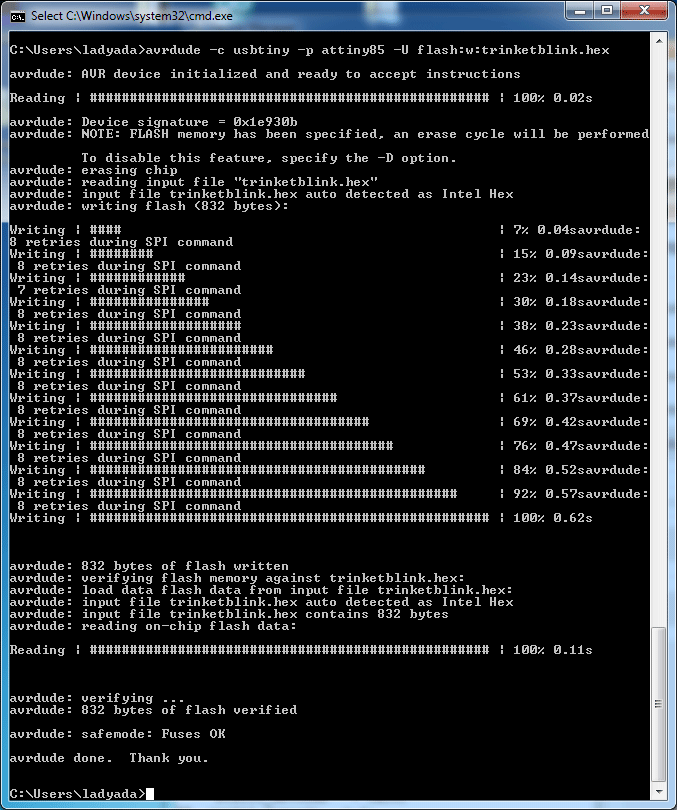- Arduino Programming Software
- Program At90s2313 With Arduino Software
- Program At90s2313 With Arduino Software Serial
- Program At90s2313 With Arduino Software Free
How to Write Arduino Software in C. The Arduino hardware-processing platform has become ubiquitous within the technology hobbyist community, and non-techies alike are getting to know it because its so simple to use. However, experienced. I'd like to use an ATMega328P for my project, I hope to do it without the arduino board. I know with the Arduino IDE and an Arduino board I can program the microcontroller. However, would it be pos.
Howdy folks!
When I first got my ATtiny2313 it took me the better part of 4 hours to finally get it programmed. I went through countless tutorials online that were old and outdated. I was never able to get the correct files from one website. I had to combine the files from several websites before I was finally able to program my ATtiny.
NOTE: With the recent update of the Arduino IDE I can't figure out how to get the boards to show up in the list. I'm sure it's easy and I'll figure it out in a bit. For now you are still going to have to use the old version of arduino for programming any ATtiny chips.
The goal of my (Current and Updated!!!) series is to find tutorials online that are old, outdated, or nonworking and make a new tutorial that I have tested and used myself.
My first i'ble in this series is how to use IR remotes to control your Arduino.
I will keep updating my i'bles in this series to work with new Arduino boards, IDEs and the like.
Now I've never tested this process on a windows but I know that it works on a mac. It should be the same for windows, just delete any mac content in the zip.
There’s an add-on for the Arduino IDE that allows you to program the ESP32 using the Arduino IDE and its programming language. In this tutorial we’ll show you how to install the ESP32 board in Arduino IDE whether you’re using Windows, Mac OS X or Linux.
Watch the Video Tutorial
This tutorial is available in video format (watch below) and in written format (continue reading this page).
If you have any problems during the installation procedure, take a look at the ESP32 Troubleshooting Guide.
If you like the ESP32, enroll in our course: Learn ESP32 with Arduino IDE.
Prerequisites: Arduino IDE Installed
Before starting this installation procedure, make sure you have the latest version of the Arduino IDE installed in your computer. If you don’t, uninstall it and install it again. Otherwise, it may not work.
Having the latest Arduino IDE software installed from arduino.cc/en/Main/Software, continue with this tutorial.
Do you need an ESP32 board? You can buy it here.
Installing ESP32 Add-on in Arduino IDE
To install the ESP32 board in your Arduino IDE, follow these next instructions:
Arduino Programming Software
In your Arduino IDE, go to File> Preferences
Enter https://dl.espressif.com/dl/package_esp32_index.json into the “Additional Board Manager URLs” field as shown in the figure below. Then, click the “OK” button:
Note: if you already have the ESP8266 boards URL, you can separate the URLs with a comma as follows:
Open the Boards Manager. Go to Tools > Board > Boards Manager…
Search for ESP32 and press install button for the “ESP32 by Espressif Systems“:
That’s it. It should be installed after a few seconds.
Testing the Installation
Plug the ESP32 board to your computer. With your Arduino IDE open, follow these steps:
1. Select your Board in Tools > Board menu (in my case it’s the DOIT ESP32 DEVKIT V1)
2. Select the Port (if you don’t see the COM Port in your Arduino IDE, you need to install the CP210x USB to UART Bridge VCP Drivers):
3. Open the following example under File > Examples > WiFi (ESP32) > WiFiScan
4. A new sketch opens in your Arduino IDE:
5. Press the Upload button in the Arduino IDE. Wait a few seconds while the code compiles and uploads to your board.
6. If everything went as expected, you should see a “Done uploading.” message.
7. Open the Arduino IDE Serial Monitor at a baud rate of 115200:
8. Press the ESP32 on-board Enable button and you should see the networks available near your ESP32:
Troubleshooting
If you try to upload a new sketch to your ESP32 and you get this error message “A fatal error occurred: Failed to connect to ESP32: Timed out… Connecting…“. It means that your ESP32 is not in flashing/uploading mode.
Having the right board name and COM por selected, follow these steps:
- Hold-down the “BOOT” button in your ESP32 board
- Press the “Upload” button in the Arduino IDE to upload your sketch:
- After you see the “Connecting….” message in your Arduino IDE, release the finger from the “BOOT” button:
Program At90s2313 With Arduino Software
- After that, you should see the “Done uploading” message
That’s it. Your ESP32 should have the new sketch running. Press the “ENABLE” button to restart the ESP32 and run the new uploaded sketch.
You’ll also have to repeat that button sequence every time you want to upload a new sketch. But if you want to solve this issue once for all without the need to press the BOOT button, follow the suggestions in the next guide:

If you experience any problems or issues with your ESP32, take a look at our in-depth ESP32 Troubleshooting Guide.

Wrapping Up
This is a quick guide that illustrates how to prepare your Arduino IDE for the ESP32 on a Windows PC, Mac OS X, or Linux computer. If you encounter any issues during the installation procedure, take a look at the ESP32 troubleshooting guide.
Program At90s2313 With Arduino Software Serial
Now, you can start building your own IoT projects with the ESP32!
Program At90s2313 With Arduino Software Free
Thanks for reading.